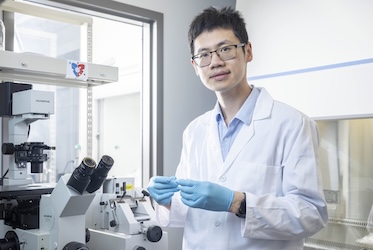
Kennesaw State undergrad researcher is shooting for the stars
KENNESAW, Ga. | Jul 15, 2024

“On top of always being a space nerd, I’ve also always been a huge LEGO nerd,” said the mechanical engineering major with a chuckle. “So, I guess it makes sense that I want to build things that go into space.”
With the help of Kennesaw State University’s Office of Undergraduate Research, the sophomore said he’s thrown himself so deeply into his work with the Summer Undergraduate Research Program that he could see himself one day enhancing space exploration technologies or helping to expand researchers’ understanding of Mars.
Brown’s recent work includes a review of the application of different types of drone designs, as well as design of a drone system for use on Earth and other planets. Brown and other undergraduate researchers, assembled during his time in the First-Year Scholars Program, have for the last year been working on a hybrid drone concept capable of flying and walking at the same time. The drone design consists of a soft robotic, flexible walking robot and a drone capable of flying to map out the walking robot’s path. Using tendon-like cords and flexible legs to traverse Mars’ surface, the soft robotics walking drone could use its more flexible design to fit into crevices or caves better than current rovers could, for example.
Though the machinery is still being constructed, the application of the finished product could allow exploration of previously unreachable areas of the exoplanets that NASA scientists say are some of the only other places known where life may have existed in the solar system.
“Right now, we have the Mars rover, which can drive around on the surface of the planet but can also easily get stuck on rocks and isn’t able to climb steep cliffs or enter tight passages,” Brown said. “Our robot's design could enable the walking portion to explore cave systems, while the flying portion could reach the tops of spires, which were previously off-limits.”
Future versions of the soft robotic system will improve mobility, strength, and reliability, promising advancements in space exploration, he said. Meanwhile, the drone portion of the system also helps traditional planetary rovers map their surroundings and find more accessible paths to take to collect samples and data.
Turaj Ashuri, interim assistant dean for academic affairs in the Southern Polytechnic College of Engineering and Engineering Technology, serves as the principal investigator on Brown and company’s research projects.
“Tommy has shown impressive potential, early as he is in his university career, to make real breakthroughs in robotics engineering,” Ashuri said. “It’s his hunger to learn, sharpen his skills and solve complex engineering problems that makes him stand out. He is not afraid to ask questions, actively seek collaboration to consider outside perspectives, take challenging tasks, and readily take direction. These traits are all indicators of a strong scientific mind, demonstrating his commitment to thorough understanding, open-mindedness, and continuous learning. His approach ensures that he remains receptive to new ideas and methodologies, fostering an environment where innovation and growth are possible.”
While Brown has always been excited about studying mechanical engineering, research in space exploration, and aspirations to work in a career exploring space, it was his experience in undergraduate research that set those passions ablaze. He now aspires to work at NASA or SpaceX.
“As far as I know, the soft robotics technology we’re using for this hybrid design concept hasn’t been used in planetary exploration so far, so that’s exciting,” Brown said. “But even if these ideas don’t take off in the complex world of space robotics as they are, KSU has provided me opportunities I don’t think I could have gotten elsewhere. I’ve learned to challenge myself to come up with new ideas, sharpen my design and problem-solving skills, learn to eloquently present my work, and deal with real and complex engineering problems of today knowing I’m prepared for what I want to do.”
– Story by Thomas Hartwell
Photos by Darnell Wilburn, Jr.
Related Stories

Kennesaw State architecture, engineering students reimagine Asheville's devastated River Arts District

Kennesaw State students to present research at Symposium of Student Scholars

KSU researcher harnessing digital twin technology to improve heart care

Chemistry student engaged in sustainable catalyst research through Kennesaw State's First-Year Scholars program
A leader in innovative teaching and learning, Kennesaw State University offers undergraduate, graduate, and doctoral degrees to its more than 47,000 students. Kennesaw State is a member of the University System of Georgia with 11 academic colleges. The university’s vibrant campus culture, diverse population, strong global ties, and entrepreneurial spirit draw students from throughout the country and the world. Kennesaw State is a Carnegie-designated doctoral research institution (R2), placing it among an elite group of only 8 percent of U.S. colleges and universities with an R1 or R2 status. For more information, visit kennesaw.edu.














